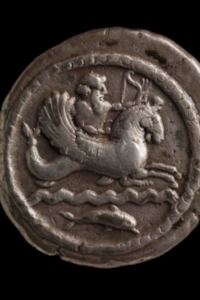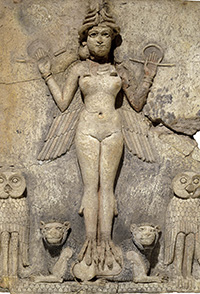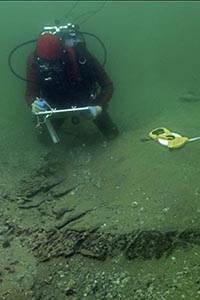
Not a Friend of ASOR yet? Sign up here to receive ANE Today in your inbox weekly!

October 2023
Vol. 11, No. 10
A Reverse History of the Pharos Lighthouse of Alexandria: From the Underwater Remains to the First Structure
By Michael Denis Higgins
The Pharos Lighthouse of Alexandria on the Mediterranean coastline of Egypt existed for 1600 years, through three major political systems, and was rebuilt and repaired many times. Yet despite the complexity of its history, there seems to be a need in the popular imagination for a unique image of the building. Commonly, such reconstructions are based on descriptions of the Islamic Pharos, slightly modified and set in a 4th-century BCE context. Here, I want to show how the Pharos may have changed with the centuries, and the easiest way to do this is to start with what remains today and go back in time toward the original structure.
Present remains of the Pharos
Underwater excavations of Alexandria’s harbor show that the Pharos must have collapsed towards the west leaving thousands of blocks on the seafloor. Most blocks are of shelly limestone and must have comprised the core of the building. This rock must have been quarried nearby but the site is lost as the land has sunk seven meters since the Pharos was built. There were also huge blocks of granite from Aswan, which were the frame of a monumental doorway that faced out towards the entrance to the harbor. Sphinxes, statues, columns, and obelisks were also found. Many of them date from the reign of Ramesses II (13th century BCE) and must have been moved downstream to furnish an otherwise undocumented temple of Isis near the Pharos.
The ruins of the Pharos can tell us about the building materials and some aspects of its construction, but to recreate the monument, we need eyewitness descriptions.
The Islamic Pharos
Alexandria was a common stopping point along the pilgrimage route from the western Mediterranean to Mecca, so we have many accounts of the Pharos from the 10th to 14th centuries. The most detailed is that of al-Balawī, a builder from Malaga, who measured the Pharos in 1165 CE. He went up a vaulted ramp and entered the basal section of the building through a utility door. He ascended an internal ramp to the first platform, where he dropped a weighted string and determined its height to be 77 meters. He continued upwards to a second octagonal story, covered with brick, and finally a circular story surmounted by a domed mosque. He returned to the ground and described a walled courtyard around the building. He mentions that there was an inscription in picture writing, probably hieroglyphic, near the top of the first story. It is this description that has been used to create most images of the Pharos, although the building was about 1400 years old at this time and had been restored recently. The accounts of another Islamic traveler showed that the Pharos collapsed between 1326 and 1349 CE.
The Roman Pharos
In contrast to the Islamic writers, the Romans did not go into much detail about the Pharos. Strabo, visiting in about 26 BCE, said it had several stories and was white. Images of the Pharos on Roman coins and a single glass vase found in Afghanistan are more informative and consistent. The square base appears to be the same as that described by Islamic writers. It was covered in stucco to protect the stone from erosion, giving the color noted by Strabo. The top of the first story held statues of Tritons, a sort of merman, and a second, narrower story was surmounted by a monumental statue, of Zeus or Poseidon probably with a steering oar in his hand. The long entrance ramp mentioned by al-Balawī was present at this time. There was a signaling hearth at the top of the Roman Pharos, probably in a columned gallery beneath the statue, and bronze mirrors may have reflected the light out towards the open sea.
The Ptolemaic Pharos
We have no images or descriptions of the earliest, Ptolemaic Pharos, just an epigram written shortly after the building was completed. This short poem suggests that the Pharos was a simple tower with a platform at the top bearing a statue of Zeus and signaling hearths. Sailing at night was rare in the 3rd century BCE, so the fires may have only been lit for ceremonial occasions.
The inspiration for the Pharos’ design may have been the monumental gateways of Egyptian temples, especially those built during the New Kingdom, such as the Luxor Temple or Temple to Amun at Thebes. These gateways commonly consisted of two tapering towers, frequently referred to as “pylons”, typically 25 meters high, with a monumental doorway in between. The pylons were not completely solid but had tunnels and stairs to access the roof, where rituals to the god Amun may have been celebrated.
If we imagine the two pylons of the gateway stacked on top of each other and the monumental doorway moved to the center of the façade of one of these pylons, then we have a structure that may resemble the original Pharos. The presence of a statue of Zeus on the top may have cemented the link with the old religion as Amun was identified as a form of Zeus. Indeed, Alexander the Great, who may have had the original idea for the Pharos, referred to his true father as Zeus-Ammon (“Ammon” was how the Greeks spelled “Amun”). The link may have been further strengthened by the construction of a temple of Isis beside the Pharos using material from one or more New Kingdom temples.
We have arrived at the original Pharos, well regarded in its time, but perhaps too utilitarian for the taste of many early writers. This may be why it was not included among the ancient seven wonders of the world listed in an epigram by Antipater of Sidon (2.58) in the late 2nd century BCE. Rather, it was only incorporated into the canonical list of the Seven Ancient Wonders during the European Renaissance, ironically after the building had collapsed in the 14th century.
Michael Higgins is an emeritus professor at the Université du Québec à Chicoutimi, Canada. His book, The Seven Wonders of the Ancient World: Science, Engineering, and Technology, was recently published by Oxford University Press.
Further Reading
Clayton PA and M. Price. 1988. The Seven Wonders of the Ancient World. Routledge, London.
Hairy I. 2006. Le phare d’Alexandrie, concentré de géométrie. La Recherche (394): 44-50
Higgins, M.D. 2023. The Seven Wonders of the Ancient World: Science, Engineering and Technology. Oxford University Press, New York.
Want To Learn More?
The Afterlife of Ships in Thonis-Heracleion: Recycling, Abandonment, and Ritual Sacrifice at an Egyptian Port
By Damian Robinson
What happens to a ship at the end of its life? Underwater archaeology at an Egyptian port near Alexandria provides a vivid picture of very different fates. Read More
 Maritime Viewscapes and the Material Religion of Levantine Seafarers
Maritime Viewscapes and the Material Religion of Levantine Seafarers
By Aaron Brody
Travel was a liminal experience for Levantine seafarers as they left behind the safety of land and existed in a state of in-betweenness on the water. What kind of religious practices did they develop to cope with the uncertainties of life at sea? Read More
 What Sorts of Rituals Really Went on Inside Late Babylonian Temples?
What Sorts of Rituals Really Went on Inside Late Babylonian Temples?
By Rocío Da Riva
Ancient temples were mysterious places filled with statues and incense. But tablets from Marduk’s temple in Babylon show they were also filled with specialists and managers following detailed lists of instructions. Read More
